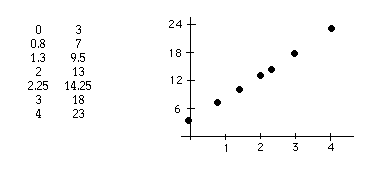
Functions
A function from set S to set T is a set of ordered pairs, the first element of which is in S and the second of which is in T, such that no first element occurs in pairs with two different second elements.
Informally, a function can be thought of as a two-column table of values, such as
The values in the left column form the set S, known as the input values or domain of the function. The values in the right column make up the set T, known as the output values or the range of the function. No element occurs twice in the first column.
3 8 5 14 2 5 7 20 4 11
Graphs
A common way of describing functions is on a coordinate graph. To graph a function, each ordered pair from the table is plotted as a point on the graph. Because no two different ordered pairs have the same first element, no two points on the graph of a function lie on the same vertical line.
To the left below is a table showing part of the infinite list of ordered pairs in a function; to the right of the table is a graph of the same function. The dots on the graph are at points whose coordinates are in the table; the lines connecting the dots and extending beyond them indicate that the list of function pairs includes pairs in between those in the finite list.

| Often the set of ordered pairs is infinite, so the function can be
described better by using variables. In the table to the right, you may notice that each output value is 5 more than the previous output value.
The function can be represented recursively as |
|
For making predictions, it's often useful to use variables in a different way: to describe a function through an explicit function expression, known as closed form expressions This kind of expression allows you to calculate the output value directly from the input value. For the above function that expression might be given by y = 5x + 13. Just substitute any input value for x in the expression 5x + 13 and you'll get the output value as y.
Graphing calculators are especially good at drawing a graph of a function when given an explicit function expression. Linear and constant functions can be graphed easily by hand.
Making statements like "if the input value is 7, the output value is 48," and asking questions such as "what's the output value if the input value is 3?" can be pretty time consuming. A shorthand gives a name to the function. Often the name f is used for a function, and we'd write f(x) = 5x + 13, but any name will suffice. Then to say "if the input value is 7, the output value is 48," you'd just write f(7) = 48. To show your work you might write f(7) = 5(7) + 13 = 48. And to ask "what's the output value if the input value is 3?" you'd just ask "What's f(3)?"
Copyright © 1999-2000 SciMathMN